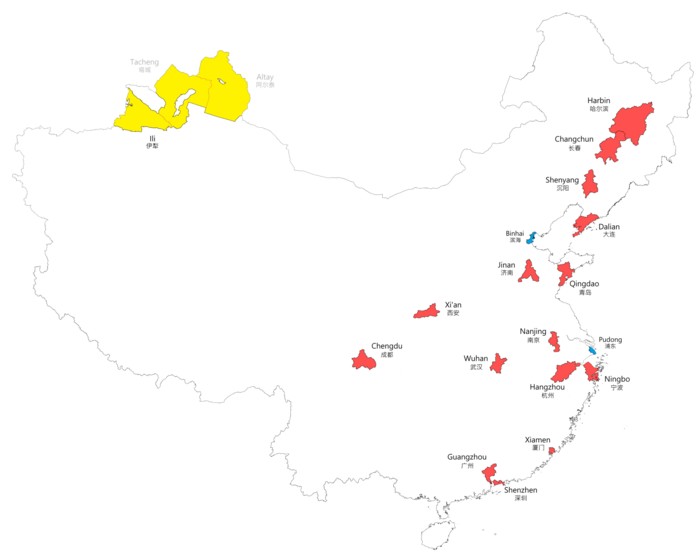Sub-provincial division
| Administrative divisions of China |
|---|
|
History:before 1912,1912–49,1949–present Administrative division codes |
Asub-provincial division(Chinese:Phó tỉnh cấp hành chính khu;pinyin:Fùshěngjí xíngzhèngqū) inChinais aprefecture-level citygoverned by aprovincepromoted by half-a-level. Thus, it ishalf-a-level under the provincial level,andhalf-a-level above the prefecture-level,hence the name "sub-provincial".
The promotion applies to all its subdivisions, administrative institutions, and political parties. For example, the mayor of a sub-provincial division is equal in status to a vice-governor of a province.
A sub-provincial division is still administratively governed by a province, just like prefecture-level divisions. However, five of them are alsocities specifically designated in the state plan(Chinese:Kế hoa đan liệt thị / kế hoa đan liệt thị), which enjoy the provincial level authority over economic issues—governmental finance, customs, economic strategy planning, economic policy, foreign economic affairs, banking, etc.
Sub-provincial divisions, similar to prefectural-level divisions, are administrative units comprising, typically, a main central urban area (the core city) surrounded by rural area, which together are divided into districts, and some surrounding counties or county-level cities (all promoted to sub-prefecture level) governed by the sub-provincial division on behalf of the province, which all have their own urban areas surrounded by their own rural areas.
Map of sub-provincial level entries in China[edit]

|
Sub-provincial municipalities[edit]
The original 16 municipalities were renamed as the sub-provincial municipalities on 25 February 1994 by theCentral Organization Committeeout of theprefecture-level municipalities.[1]They are mostly thecapitalsof the provinces in which they are located.
Currently, there are 15 sub-provincial municipalities after Chongqing was designated direct-control:[2]
Chongqingwas formerly a sub-provincial municipality ofSichuanuntil 14 March 1997, when it was made an independent municipality by splitting it out of Sichuan altogether. TheXinjiang Production and Construction Corpsalso has the powers of a sub-provincial division.
Chengduis the largest sub-provincial municipality. It has a population exceeding that of the independent municipality ofTianjinwhile bothHarbinand Chengdu have a bigger land area than Tianjin.
In total, there are five sub-provincial municipalities that are not themselves provincial capitals. These five municipalities have been designated as the "Municipalities with Independent Planning Status"(simplified Chinese:Kế hoa đan liệt thị;traditional Chinese:Kế hoa đan liệt thị;pinyin:Jìhuá Dānliè Shì).
Sub-provincial new areas[edit]
Additionally, the head ofPudong New AreaofShanghaiandBinhai New AreaofTianjin,which is acounty-leveldistrict,is given sub-provincial powers.
| Division name | Simplified Chinese | Hanyu Pinyin | Municipality | Abbreviation | Region | Population (2010 Census) | Date of designation | Subdivision |
|---|---|---|---|---|---|---|---|---|
| Binhai New Area | Tân hảiTân khu | Bīnhǎi Xīn Qū | Tianjin | Tân hải | North | 2,482,065 | 2009 | 19Subdistricts& 7towns(11 special township-level zones) |
| Pudong New Area | Phổ đôngTân khu | Pǔdōng Xīn Qū | Shanghai | Phổ đông | East | 5,044,430 | 1992 | 13Subdistricts& 25towns(6 special township-level zones) |
Sub-provincial autonomous prefecture[edit]
Ili Kazakh Autonomous Prefecturehas the two prefectures ofAltaiandTachengand 11 directly-controlled county-level administrative divisions under its jurisdiction. It itself is legally only a prefecture-level division, which is a special case in China's administrative divisions. It is not accurate to regard Ili Kazakh Autonomous Region as a sub-provincial administrative division, which has no legal basis. Up until 2001, the Autonomous Prefecture had a 3rd prefecture as well. The directly controlled subdivisions were administered as part of Ili Prefecture ( y lê địa khu )
| Division name | Simplified Chinese | Hanyu Pinyin | Province | Abbreviation | Region | Population (2010 Census) | Date of designation | Subdivision |
|---|---|---|---|---|---|---|---|---|
| Ili Kazakh Autonomous Prefecture | Y lêCáp tát khắcTự trị châu | Yīlí Hāsàkè Zìzhìzhōu | Xinjiang | Y lê | Northwest | 4,305,119 | 1979 | (2prefectures) 5county cities,17counties& 2autonomous counties |
Sub-provincial Municipal Conference[edit]
The National Joint Conference of Sub-provincial City People's Congress Standing Committee Chairpersons (Toàn quốc phó tỉnh cấp thành thị nhân đại thường ủy hội chủ nhậm liên tịch hội nghị) are attended by the chairpersons and vice-chairpersons of all sub-provincial cities. It was proposed by the Guangzhou Municipal People's Congress in 1985. The conferences:
- Guangzhou (26 February – 4 March 1985)
- Harbin (27–31 August 1985)
- Wuhan (20–24 May 1986)
- Dalian (10–14 August 1987)
- Xi'an (9–13 September 1988)
- Shenyang (13–17 August 1990)
- Chongqing (22–26 November 1991)
- Qingdao (3–7 May 1992)
- Shenzhen (25–28 October 1993)
- Nanjing (1–4 November 1994)
- Changchun (21–24 May 1995)
- Hangzhou (20–24 October 1996)
- Jinan (19–25 October 1997)
- Xiamen (12–16 October 1998)
- Ningbo (17–20 October 1999)
- Chengdu (10–13 October 2000)
- Guangzhou (30 October – 3 November 2001)
- Harbin (23–26 July 2002)
- Wuhan (8–12 October 2003)
- Shenyang (31 August – 6 September 2004)
- Qingdao (6–8 September 2005)
- Shenzhen (20–23 October 2006)
- Dalian (14–16 August 2007)
- Xi'an (13–16 April 2009)
- Nanjing (18–20 October 2010)
- Changchun (22–25 August 2011)
References[edit]
- ^Trung ương cơ cấu biên chế ủy viên hội ấn phát 《 quan vu phó tỉnh cấp thị nhược càn vấn đề đích ý kiến 》 đích thông tri. Trung biên phát [1995]5 hào.Đậu đinh võng. 1995-02-19. Archived fromthe originalon 2014-05-29.Retrieved2014-05-28.
- ^Xue Hongli ( tiết hoành lị ) (2008-05-07).15 cá phó tỉnh cấp thành thị trung cáp nhĩ tân thị phòng giới trướng phúc bài liệt đệ ngũ danh[Prices rose in 15 sub-provincial cities, Harbin ranked fifth].Cáp nhĩ tân địa sản(in Simplified Chinese). Sohu.Retrieved2008-06-11.
- ^abcReferences and details on data provided in the table can be found within the individual municipality articles.
